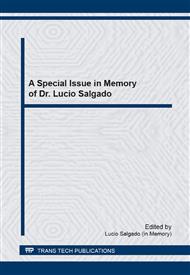p.651
p.657
p.662
p.667
p.672
p.678
p.684
p.690
p.694
Study of Chocolate Clay (Boa Vista, Paraíba) Organophilization Using the Mixture of Quaternary Ammonium Salts through Direct Method
Abstract:
The organoclays contain intercalated organic molecules in their structural layers. The more clay used to prepare organoclays are those derived from the smectite group bentonites mainly due to the small size of crystals and high cation exchange capacity, which facilitate the intercalation of organic compounds. This work aims to obtain organoclays from a mixture of two different quaternary ammonium salts in a 1:1 ratio through the direct method of organophilization. This procedure will be performed using the clay Chocolate from the municipality of Boa Vista, Paraíba state, which has in its composition of smectite clay minerals group. The samples were characterized by X-ray diffraction (XRD) and infrared spectroscopy (IR). The testing Foster swelling in a later step, using different organic solvents: gasoline, diesel and kerosene were used to investigate the compatibility clays after modification with the salts.
Info:
Periodical:
Pages:
672-677
Citation:
Online since:
September 2014
Price:
Сopyright:
© 2015 Trans Tech Publications Ltd. All Rights Reserved
Share:
Citation:


